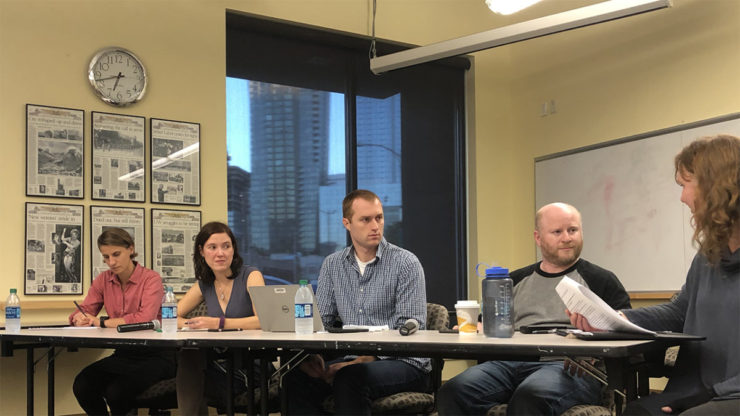
The panel was promoted as “The Art of the Interview.” And based on the range of advice from four Seattle-based journalists, effective interviewing – arguably every reporter’s primary tool – is as much a mindful art as a set list of questions.
The conversation was hosted by the Northwest Science Writers Association, a non-profit affiliated with the National Science Writers Association. The field of science, medical and environmental journalism can present its own range of particular (but not entirely unique) challenges: building trust with sources for sensitive stories; translating complex ideas to a general public without dumbing them down; deciphering and probing research findings; engaging reluctant sources and skeptical scientists. The interview dynamic also can be affected by the reporter’s affiliation: working for a traditional news outlet, freelancing or writing as part of a university’s in-house communications team.
While each reporter brings his or her own style and purpose to interviews, they agreed on this: The best interviews start with planning and pragmatic groundwork. But they also embrace the serendipity of rambling stories, unexpected asides and unforeseen moments.
The panel was moderated by Elizabeth Sharpe, who writes about science and technology for the University of Washington. Here were some top take-aways:
- PREPARING – WITHOUT OVER-PREPARING: Different kinds of interviews require different preparation. For a feature about a scientist, a reporter may read technical articles about his or her work, or watch a video of a presentation he or she made. For a public figure, some of the homework might involve finding a fresh path through a well-trod story. Backgrounding is essential, but so is avoiding the trap that can come with too much prep. That trap? Forgetting that your audience’s knowledge is far behind yours, especially after you’ve immersed yourself in a topic. “You need to re-set before the interview and remember the listener comes to the story with zero,” said Gabriel Spitzer, host of “Sound Effect” on KNKX public radio. “Your temptation may be to show off what you know, but the expert has to spell everything out.”
- BUILDING TRUST: Part of good interview prep involves determining the concerns of a story source. Being straightforward and direct with a source about what you hope to learn may help build enough trust for them to relax and provide more intimate details from their life and work. “The more you listen, the more people want to let you into their lives,” said Madeline Ostrander, a freelancer who roams the Pacific Northwest for stories about the environmental consequences of individual and societal choices. Ostrander once spent two days with a couple on in San Juan islands in Washington state learning about indigenous root vegetables for a feature for Hakai Magazine. She walked the beaches with them as they described the island’s local flora and ecology. The hours invested paid off in their increasing with Ostrander’s questions. By the visit’s end, she was invited to their home to cook camas.
- INVESTING TIME AND PERSISTENCE: Investigative reporter Mike Baker teamed with Seattle Times colleague Justin Mayo for a series that exposed lapses in protocols, billing procedures and surgeon oversight at Swedish-Cherry Hill, one of the region’s prestigious neuroscience institutes. The project, which won the 2018 Selden Ring Award, prompted numerous resignations and reforms at Swedish. The project relied on extensive and methodical data-based reporting. It also required Baker to gain the trust of relatives of a 23-year-old woman who died after surgery at Swedish. “It was a long process,” Baker said. He started with family members on the outskirts of the young woman’s inner circle. Slowly, the entire family, including the woman's grief-stricken parents, realized he was working on a larger story in which their daughter’s struggles provided an essential human element. Baker says he thinks of sources in a concentric circle, working his way slowly from the outside into the center.
- PAINTING SCENES: To pull readers into a story, the writer must build scenes, and that requires description. Eliciting the right details from sources often requires patience and creativity. For a story in Seattle Met magazine about noise pollution, Ostrander interviewed a veteran with post-traumatic stress disorder who was out on a hike when a military jet roared low overhead. The noise so alarmed him that he jumped into nearby forest undergrowth. Ostrander asked the vet specific questions to help reconstruct his hike: What were you wearing? When he told her he was walking barefoot, she asked: What kinds of plants were under your feet? She says she sometimes explains to her sources that she’s trying to bring readers into a particular moment, and needs sensory and visual details.
- GETTING TO PITHY: There are also times when a reporter needs a short summary. EarthFix reporter Eilis O’Neill of KUOW public radio sometimes lets a source meander through their own telling of a situation, then repeats their story back to them with less detail, deliberately oversimplifying. That can prompt the source to correct her and re-state things beautifully. Asking people to repeat themselves more succinctly can be awkward, she admits. To make it less so, she might ask a source to explain things “as if you are talking to my 5-year-old nephew.” Or she will ask them to imagine the distractions tugging at the attentions of her radio audience: “Can you make it easier on them if they are driving in traffic and listening?”
- RAMBLING: Does a reporter need to keep a wayward person from rambling on and on about the wrong topic? KUOW’s O’Neill says no: “Let them ramble.” Other panelists shared examples of times that letting people talk helped establish trust and intimacy. Spitzer, of KNKX, said he deliberately asks short questions, and when an answer is offered, he waits for the pregnant silence to loom larger and larger: “It has the weird power to make them open up.”




